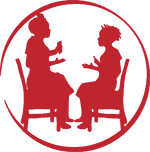Interpersonal Communication
Part 2 > Essential Element 6 > Consider Communication Channel Pros & Cons for Use with Urban Youth > Interpersonal Communication
What is it?
Personal interaction with the intended audience that could be done one-on-one, in small groups, large groups or as a forum. IPC can be delivered in many formats—in person, over the phone (e.g., hotline) via social media—as well as by any number of health providers, peers and near-peers, community health workers, pharmacists and teachers, to name a few.
Pros and Cons
- One-on-one IPC can personalize interaction and address that person’s specific situation and is effective for discussing sensitive topics in a private setting, but requires trained educators/ facilitators and oversight to ensure all are delivering the same message.
- Small group IPC can engage small interpersonal networks (i.e., peers) for social support, but may need repeated sessions and people may not be able to attend regularly.
- Large group IPC can reach more people and challenge dominant norms and resistant behaviors, but large group IPC activities are the least interactive and personalized, and often more “health education” style and challenging to manage.
- Peer educators can be effective because they are approximately the same age as the intended audience, speak the same language and are easy to relate to, but effectiveness depends on the quality of the program—some peer educators might find it difficult to move beyond simply sharing information to helping build skills for behavior change.
 Reminders for using IPC
Reminders for using IPC
- Communication should be interactive and avoid lectures and one-way communication.
- Adapt existing materials or develop new materials, including:
- A curriculum or guide for facilitators, role-play scripts, games, photos, other visuals and tools to train facilitators.
- Branded items for staff/volunteers that identify them with the program (e.g., hat, T-shirt, bag).
- Print materials for the intended audience (e.g., brochure, flier, comic books).
- Determine the number of sessions that participants need to attend and find ways of ensuring regular participation.
- Decide on the type of facilitators (i.e., peer, near-peer, program staff and teachers).
- Recruit and train IPC facilitators. Supervision of your IPC facilitators (including observation visits) is key to success. Include regular meetings and feedback to make sure everyone is consistent in message delivery.
Example
Nyeri Youth Health Project (Kenya), trained young parents to be “friends of youth” and shared knowledge and skills regarding SRH with youth individually or in groups, community adults and teachers; and referred youth to newly trained youth-friendly private sector clinics.
Considerations for using IPC in an urban environment
- Outreach can be to youth in places that are less conventional—there is a variety of places where they hang out or are found on the street.
- Urban areas have a diverse group of people who can share their expertise and give talks (e.g., therapists, medical providers).
- With high unemployment in urban areas, there are plenty of youth available to be trained as peer educators.


